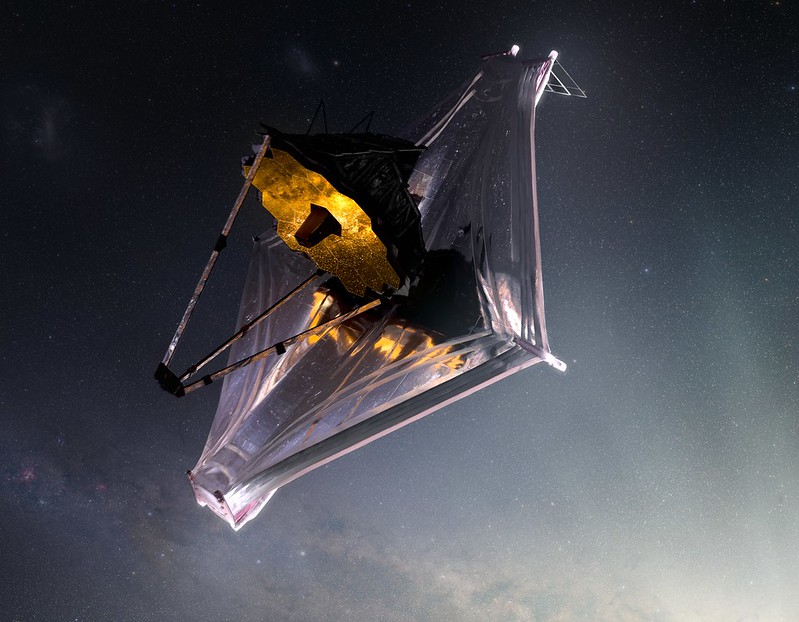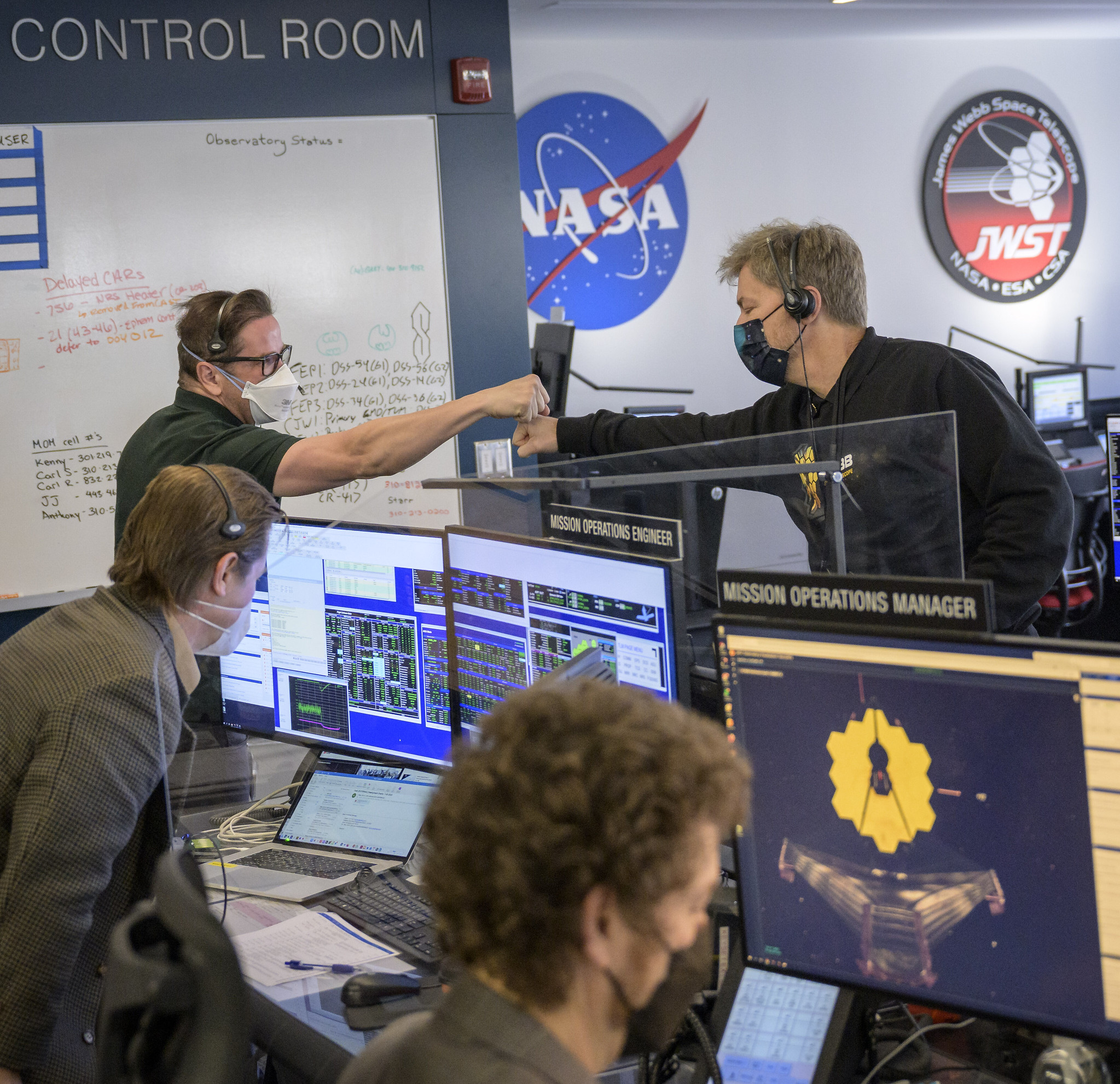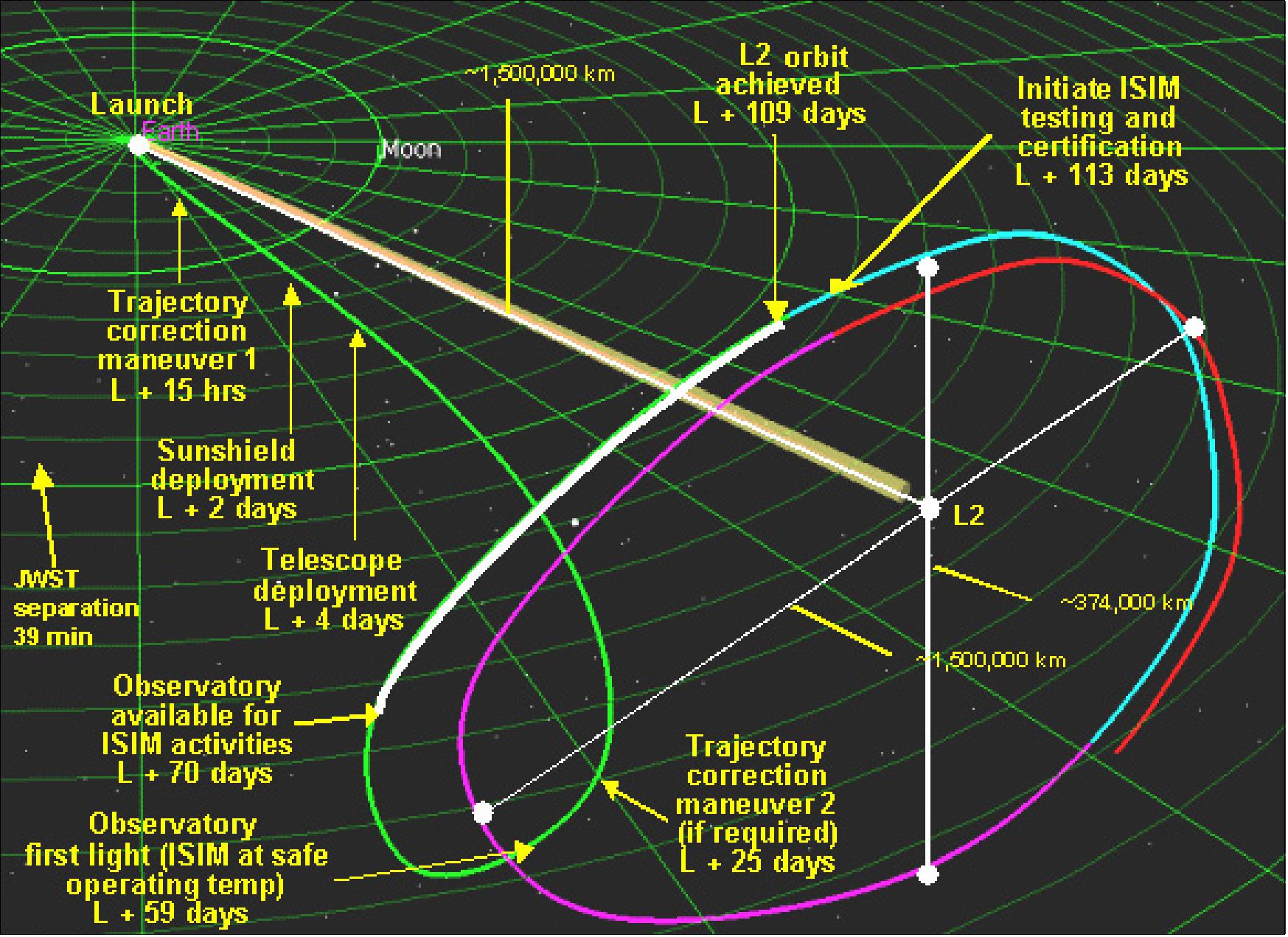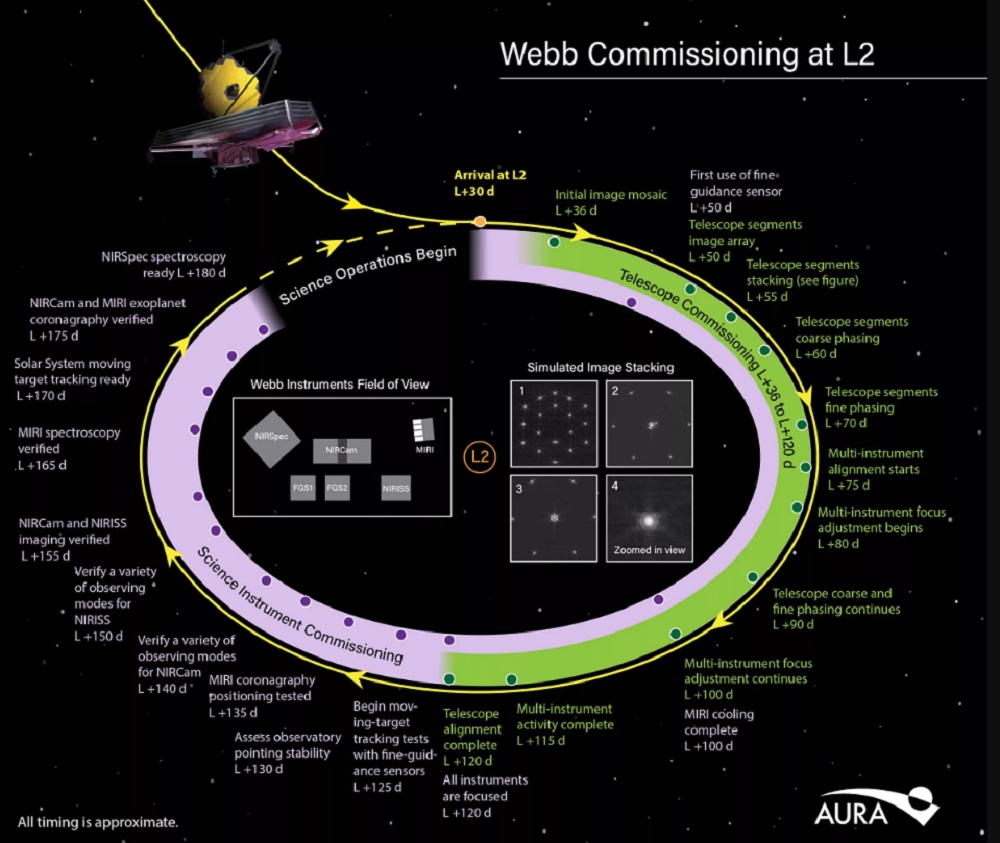Fully deployed, the James Webb Space Telescope arrived at its new home today, in a halo orbit around the Earth-Sun L2 Lagrange point.

NASA
NASA’s newest space telescope has arrived at its new home in space. On Monday January 24th at 2:00 p.m. EST (19:00 UT), the James Webb Space Telescope (JWST) fired its thrusters for five minutes, putting it into the start of a halo (Lissajous) orbit around the Sun-Earth (L2) Lagrange point 1.5 million km (almost a million miles) beyond Earth's orbit. Engineers reported that the telescope is in good health.
“Webb, welcome home!” said Bill Nelson (NASA-Administrator) in a recent press release. “Congratulations to the team for all of their hard work ensuring Webb’s safe arrival at L2 today. We’re one step closer to uncovering the mysteries of the universe.”
They're not the only ones rejoicing. Amateurs and ground-based telescopes tracked JWST all the way to its destination:
Caught the #jameswebbtelescope from my backyard! Timelapse of 5-min exposures from 9-10:20 PM. @NASAWebb #space #astronomy #astrophotography pic.twitter.com/bkTg3WXVAV
— Molly Wakeling (@mollycule509) January 22, 2022
The Path So Far
Launched on Christmas Day 2021 from the Guiana Space Center, JWST took just over 29 days to transit from Earth to L2. The Ariane 5 rocket launch was so accurate that less fuel than anticipated was required for the two planned mid-course correction burns. In fact, the rocket deliberately underpowered the launch by a small amount, so the observatory would not overshoot its target. (If it did, it would have had to rotate sunward to "put on the brakes," wasting precious fuel and exposing the optics to the Sun.) With the course correction burns complete, team engineers now estimate that JWST will have enough fuel to last well past its 10-year planned extended mission.
Fitting the 6.5-meter mirror observatory in the Ariane 5 rocket fairing necessitated the design of a telescope that could fold up in a stowed-away configuration for launch, then unfold once it was in space.
Along the way to L2, the observatory unfurled and tensioned its sunshield, unfolded its primary and secondary mirrors, and performed small correction burns, as controllers learned just how the telescope and components would react to the cold vacuum of space.

NASA / Bill Ingalls
The controllers also issued the commands for 132 actuators on the primary and secondary mirrors to drive 18 mirror segments out of their stowed launch position for initial individual focusing and adjustment. They didn't move far — the primary segments moved only 12.5 millimeters. An additional 18 "radius of curvature" actuators drove out of their stowed launch position as well. These will bend the segments of the primary to give the parabolic mirror its initial curvature.
Welcome to L2
As an infrared telescope, the joint Canadian Space Agency/European Space Agency/NASA observatory must stay at a super-cold 40 kelvin (-233°C/-387°F) for scientific observations. The gigantic sunshield is crucial to keeping the observatory cold, as is the telescope's orbit: a a halo orbit around L2.
At L2, JWST will orbit the Sun in time with Earth, but 1.5 million km in the opposite direction from the Sun. This is the perfect location for an infrared space telescope, as it can stay permanently oriented away from the heat signatures of both the Sun and Earth.
“If Webb was exactly at L2, then it would be difficult to transmit data back to Earth, because there would be interference from the Sun,” says Heidi Hammel (NASA/GSFC). “This orbit also keeps the telescope out of the shadow of the Moon, as well as the Earth. Finally, this ‘halo orbit’ requires the least amount of fuel for ‘station-keeping’ (keeping the telescope in orbit there at L2).”

ESA / EO Portal
The potato chip-shaped orbit at L2 is meta-stable, meaning it has a saddle-shape gravity gradient similar to the balancing point on a ridge. Therefore, the telescope needs to use its thrusters for small station-keeping corrections once every three weeks to keep it in a six-month, 232,000 mile (374,000 km) wide orbit around L2.
What's Next for JWST
The telescope’s optics now need to reach their wavefront configuration, as the mirrors are moved in nanometer and micron increments to achieve alignment.
“The next major activity for Webb is the alignment of the primary mirror segments, so that they work together as one mirror,” says Hammel. “This long, complex process will likely take a few months. Throughout that time, the instruments (cameras and spectrographs) will continue to cool. After the optical alignment is complete, then the final commissioning of the instruments takes place.”
Expect to see the first light for James Webb around L+36 days (early February), with an initial calibration mosaic. It won't be pretty — yet. Further alignment will result in improved images, and we can expect the first science observations by this summer.

STScI / AURA
And you thought that collimating your Newtonian for a night’s worth of driveway observing was hard. Still, the deployment of JWST has gone by the numbers thus far. Now, it's time to get down callibration and commissioning in preparation for the ground-breaking science that JWST is set to deliver.
 8
8









Comments
Matt-Immenschuh
January 25, 2022 at 2:04 pm
Are there any other spacecraft in L2?
You must be logged in to post a comment.
Anthony Barreiro
January 25, 2022 at 5:51 pm
According to the wikipedia page
https://en.wikipedia.org/wiki/List_of_objects_at_Lagrange_points#L2
There are currently three spacecraft at L2: ESA's Gaia, the Russian-German Spektr-RG, and the James Webb Space Telescope.
Spacecraft previously at L2 included NASA's Wilkinson Microwave Anisotropy Probe and ESA's Planck spacecraft (both of which mapped the cosmic microwave background radiation), and ESA's Herschel infrared space telescope. The wikipedia page lists seven missions in the planning stages to go to L2, including ESA's Euclid and NASA's Nancy Grace Roman Space Telescope.
Apparently since spacecraft orbit around L2, there's plenty of room. Until one probe photobombs another probe's astrophotography, everybody should get along okay.
You must be logged in to post a comment.
Monica Young
January 27, 2022 at 9:10 am
Indeed, the Gaia satellite team even greeted JWST upon its arrival 😉
https://twitter.com/ESAGaia/status/1485892871106568193
You must be logged in to post a comment.
astro3ron
January 27, 2022 at 7:39 pm
Thanks Monica. Have you gotten any visual observations from members estimating the visual mag and size of scope used? From photo/movies posted it looked around 12th or so.
You must be logged in to post a comment.
Monica Young
January 28, 2022 at 3:39 pm
I've seen around 16th and 17th magnitude reported on the Minor Planet Mailing List.
You must be logged in to post a comment.
astro3ron
January 27, 2022 at 2:51 pm
Is this article going to be published in a future S&T edition? I don't see in in Feb or March 2022.
You must be logged in to post a comment.
Monica Young
January 27, 2022 at 4:39 pm
We produce our issues several months in advance — we are currently working on the May issue!
You must be logged in to post a comment.
ransak
January 28, 2022 at 4:35 pm
Thanks for another great article! The launch was much more accurate than the controllers' fist bump. So looking forward to first images!
You must be logged in to post a comment.
You must be logged in to post a comment.